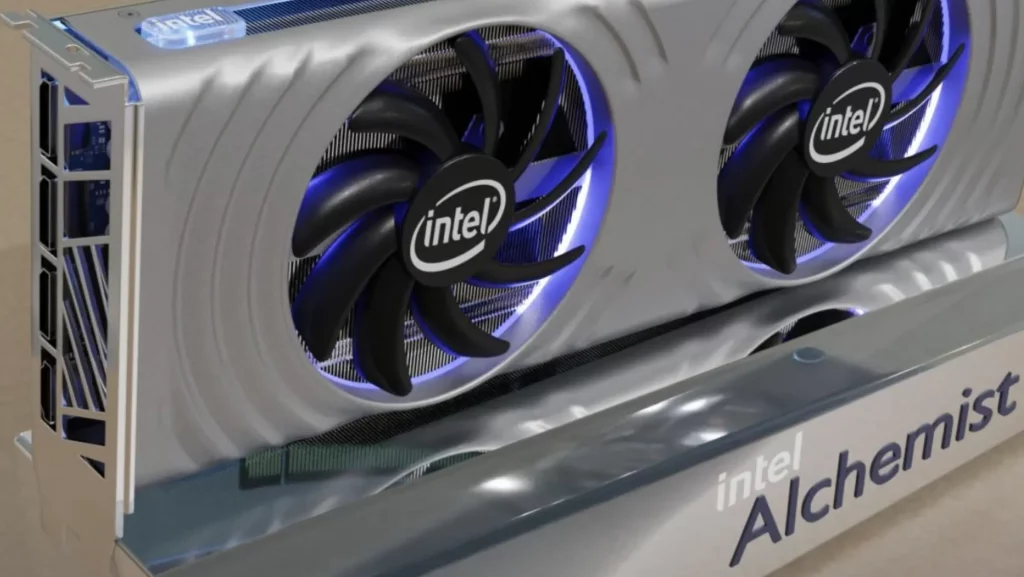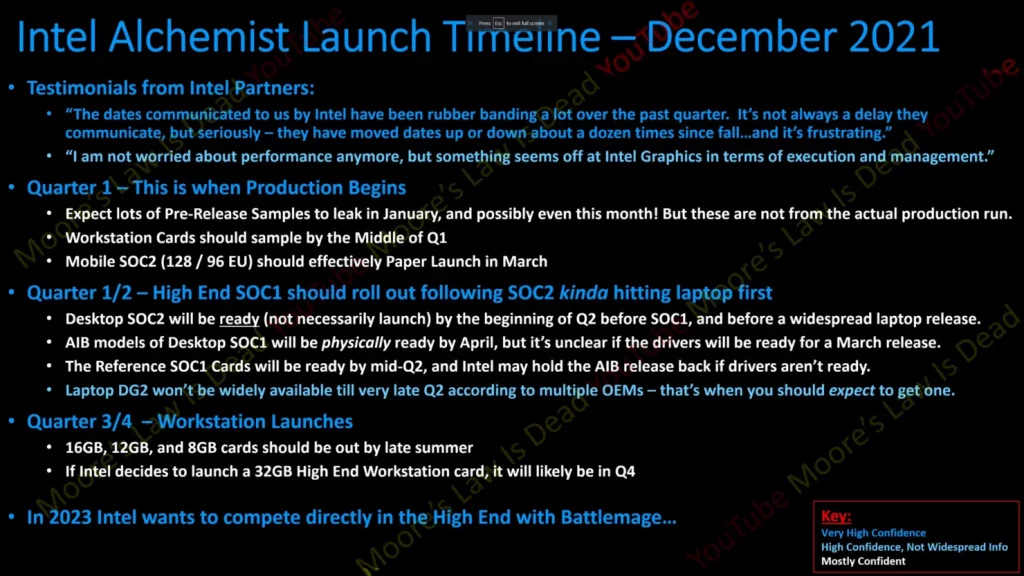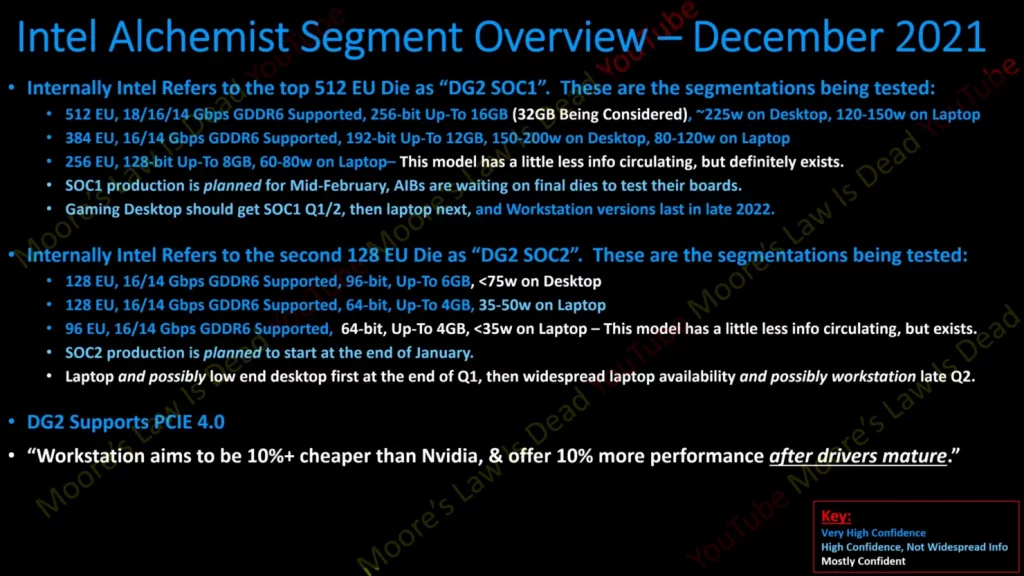The ARC Alchemist Gaming GPUs from Intel have been further described, and it appears that there will be a plethora of SKUs available for gamers and workstation customers on desktops and notebooks.
We discuss workstation and gaming together because Intel’s ARC Alchemist lineup’s core architecture is primarily built for gaming, as evidenced by the naming scheme of Xe-HPG (High-Performance Gaming). The latest information from Moore’s Law is Dead includes initial die closeups of the two DG2 SKUs that will be utilized on Intel’s first ARC graphics cards, as well as information on the graphics lineup.
Intel’s ARC Alchemist range will include two GPU dies, each with multiple configurations, and will be available in Q1 2022. Three configurations based on the top DG2-512 EU (DG2-SOC1) die will be available, as well as three configurations based on the DG2-128 EU (DG2-SOC2) die.
Intel ARC Alchemist (Xe-HPG DG2) Graphics Lineup Details (Image Credits: Moore’s Law is Dead):
Although we have seen more GPU configurations in leaks, it appears that those were either early SKUs used for validation and testing or may be used in future products. So, let’s begin with the top die.
Intel Xe-HPG 512 EU GPU Powered ARC Alchemist Gaming Graphics Lineup
At least three configurations are claimed to be available for the top Alchemist 512 EU (32 Xe Cores) model. The entire device has 4096 cores, a 256-bit bus interface, and up to 16 GB of GDDR6 memory with a 16 Gbps rate, however, 18 Gbps is possible, according to rumors.
Following are all the ARC 512 EU variants that we can expect based on the DG2-SOC1:
- 512 EU (4096 ALUs) / 16 GB @ Up To 18 Gbps / 256-bit / 225W (Desktops) & 120-150W (Laptops)
- 384 EU (3072 ALUs) / 12 GB @ Up To 16 Gbps / 192-bit / 150-200W (Desktops) & 80-120W (Laptops)
- 256 EU (2048 ALUs) / 8 GB @ Up To 16 Gbps / 128-bit / 60-80W (Laptops)
The Alchemist 512 EU chip will have a surface area of roughly 396mm2, making it larger than AMD’s rDNA 2 and NVIDIA’s Ampere offerings. The BGA-2660 package, which measures 37.5mm by 43mm, will house the Alchemist -512 GPU. The Ampere GA104 from NVIDIA is 392mm2 in size, which is comparable to the flagship Alchemist chip, but the Navi 22 GPU is 336mm2 in size, or around 60mm2 less. This isn’t the chip’s ultimate die size, but it should be close.

NVIDIA’s chips have tensor cores as well as substantially larger RT/FP32 cores, whilst AMD’s rDNA 2 chips include a single ray accelerator unit per CU as well as Infinity Cache. Raytracing and AI-assisted super-sampling technology will be supported by specific hardware onboard Intel’s Alchemist GPUs.
The Xe-HPG Alchemist 512 EU processor is said to have clock speeds between 2.2 and 2.5 GHz, although we don’t know if they are typical or maximum boost speeds. Assuming that this is the maximum clock speed, the card would deliver up to 18.5 TFLOPs FP32 computation, which is 40% more than the RX 6700 XT but 9% less than the NVIDIA RTX 3070.

On desktops, the top 512 EU variant is expected to compete against the RTX 3070 / RTX 3070 Ti, while the 384 EU variant is expected to fight against the RTX 3060 / RTX 3060 Ti. On the laptop side, the 512 EU variant may be as fast as the RTX 3080, the 384 EU variant will be comparable to the RTX 3070, and the 256 EU will compete with the RTX 3060.

Intel’s initial TDP target was 225-250W, but that has already been increased to roughly 275W. If Intel wants to push its clocks even higher, we can expect a 300W variant with dual 8-pin connectors. In terms of timing, the SOC1 variations are expected to be released in mid-February, and while AIBs wait for final dies to test with their PCB designs, desktop variants could be released first, followed by laptops, and finally workstations in late 2022.
Intel Xe-HPG 128 EU GPU Powered ARC Alchemist Gaming Graphics Lineup
Last but not least, the Intel Xe-HPG Alchemist 128 EU (8 Xe Cores) components. The full-fat SKU with 1024 cores is available in two configurations: a 96-bit and a 64-bit edition with 6 GB and 4 GB memory capacity, respectively.
Following are all the ARC 128 EU variants that we can expect based on the DG2-SOC2:
- 128 EU (1024 ALUs) / 6 GB @ Up To 16 Gbps / 96-bit / ~75W (Desktops)
- 128 EU (1024 ALUs) / 4 GB @ Up To 16 Gbps / 64-bit / 35-30W (Laptops)
- 96 EU (768 ALUs) / 4 GB @ Up To 16 Gbps / 64-bit / ~35W (Laptops)
Performance should be comparable to the GeForce GTX 1650 and GTX 1650 SUPER, but with raytracing. One significant advantage Intel may have over AMD and Intel with these cards is that they may be able to join the sub-$250 US market, which has been largely ignored in the current generation of cards. So far, the GeForce RTX 3050 series has only seen a laptop release, with the RTX 3060 serving the entry-level Ampere category at $329 US, while AMD’s entry-level option, the RX 6600, is projected to cost around $300 US.
also read:








